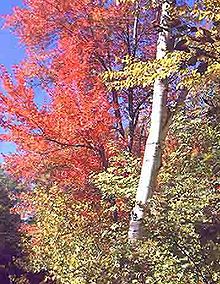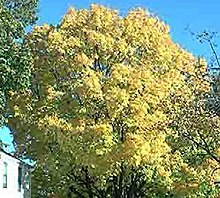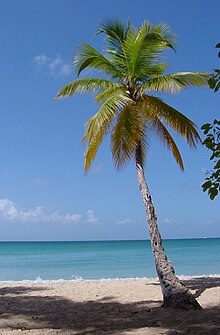This is an old revision of this page, as edited by BerneyBoy (talk | contribs) at 13:26, 10 June 2005. The present address (URL) is a permanent link to this revision, which may differ significantly from the current revision.
Revision as of 13:26, 10 June 2005 by BerneyBoy (talk | contribs)(diff) ← Previous revision | Latest revision (diff) | Newer revision → (diff)- This article is about the biological organisms known as trees. For other meanings of the word see tree (disambiguation).
A tree can be defined as a large, perennial, woody plant. Though there is no set definition regarding minimum size, the term generally applies to plants at least 6 m (20 ft) high at maturity and, more importantly, having secondary branches supported on a single main stem or trunk (see shrub for comparison). Compared with most other plant forms, trees are long-lived. A few species of trees grow to 100 m tall, and some can live for several millennia.
Trees are important components of the natural landscape and significant elements in landscaping, and in agriculture supplying orchard crops (e.g. apples). Trees also play an important role in many of the world's mythologies (see Tree (mythology)).
Classifications

A tree is a plant form and trees occur in many different orders and families of plants. Trees thus show a wide variety of growth form, leaf type and shape, bark characteristics, reproductive structures, etc.
The earliest trees were tree ferns and horsetails, which grew in vast forests in the Carboniferous Period; tree ferns still survive, but the only surviving horsetails are not of tree form. Later, in the Triassic Period, conifers, ginkgos, cycads and other gymnosperms appeared, and subsequently flowering plants in the Cretaceous Period. Most species of trees today are flowering plants and conifers. The listing below gives examples of many well known trees and how they are typically classified.
A small group of trees growing together is called a grove or copse, and a landscape covered by a dense growth of trees is called a forest. Several biotopes are defined largely by the trees that inhabit them; examples are rainforest and taiga (see ecozones). A landscape of trees scattered or spaced across grassland (usually grazed or burned over periodically) is called a savanna.
Morphology
The basic parts of a tree are the roots, trunk(s), branches, twigs and leaves. Tree stems consist mainly of support and transport tissues (xylem and phloem). Wood consists of xylem cells, and bark is made of phloem and other tissues external to the vascular cambium.
Trees may be broadly grouped into exogenous and endogenous trees according to the way in which their stem diameter increases. Exogenous trees, which comprise the great majority of modern trees (all conifers, and all broadleaf trees), grow by the addition of new wood outwards, immediately under the bark. Endogenous trees, mainly in the monocotyledons (e.g. palms), grow by addition of new material inwards.
As an exogenous tree grows, it creates growth rings. In temperate climates, these are commonly visible due to changes in the rate of growth with temperature variation over an annual cycle. These rings can be counted to determine the age of the tree, and used to date cores or even wood taken from trees in the past; this practice is known as the science of dendrochronology. In some tropical regions with constant year-round climate, growth is continuous and distinct rings are not formed, so age determination is impossible. Age determination is also impossible in endogenous trees.

The roots of a tree are generally embedded in earth, providing anchorage for the above-ground biomass and absorbing water and nutrients from the soil. Above ground, the trunk gives height to the leaf-bearing branches, aiding in competition with other plant species for sunlight. In many trees, the arrangement of the branches optimizes exposure of the leaves to sunlight.
Not all trees have all the plant organs or parts mentioned above. For example, most palm trees are not branched, the saguaro cactus of North America has no functional leaves, tree ferns do not produce bark, etc. Based on their general shape and size, all of these are nonetheless generally regarded as trees. Indeed, sometimes size is the more important consideration. A plant form that is similar to a tree, but generally having smaller, multiple trunks and/or branches that arise near the ground, is called a shrub. However, no sharp differentiation between shrubs and trees is possible. Given their small size, bonsai plants would not technically be 'trees', but one should not confuse reference to the form of a species with the size or shape of individual specimens. A spruce seedling does not fit the definition of a tree, but all spruces are trees. Bamboos by contrast, do show most of the characteristics of trees, yet are rarely called trees.
Champion trees
The world's champion trees can be considered on several factors; height, trunk diameter or girth, total size, and age. It is significant that in each case, the top position is always held by a conifer, though a different species in each case; in most measures, the second to fourth places are also held by conifers.
- Tallest trees
The heights of the tallest trees in the world have been the subject of considerable dispute and much (often wild) exaggeration. Modern verified measurement with laser rangefinders combined with tape drop measurements made by tree climbers, carried out by the U.S. Eastern Native Tree Society has shown that most older measuring methods and measurements are unreliable, often producing exaggerations of 5% to 15% above the real height. Historical claims of trees of 114 m, 117 m, 130 m, and even 150 m, are now largely disregarded as unreliable, fantasy or outright fraud. The following are now accepted as the top five tallest reliably measured species:
- Coast Redwood Sequoia sempervirens: 112.83 m, Humboldt Redwoods State Park, California (Gymnosperm Database)
- Coast Douglas-fir Pseudotsuga menziesii: 100.3 m, Brummit Creek, Coos County, Oregon (Gymnosperm Database)
- Sitka Spruce Picea sitchensis: 96.7 m, Prairie Creek Redwoods State Park, California (Gymnosperm Database)
- Giant Sequoia Sequoiadendron giganteum: 93.6 m, Redwood Mountain Grove, California (Gymnosperm Database)
- Australian Mountain-ash Eucalyptus regnans: 92.0 m, Styx Valley, Tasmania (Forestry Tasmania )
- Stoutest trees
The girth (circumference) of a tree is - or at least should be - much easier to measure than the height, as it is a simple matter of stretching a tape round the trunk, and pulling it taut to find the circumference. Despite this, U.K. tree author Alan Mitchell made the following comment about measurements of yew trees in the British Isles:
- "The aberrations of past measurements of yews are beyond belief. For example, the tree at Tisbury has a well-defined, clean, if irregular bole at least 1.5 m long. It has been found to have a girth which has dilated and shrunk in the following way: 11.28 m (1834 Loudon), 9.3 m (1892 Lowe), 10.67 m (1903 Elwes and Henry), 9.0 m (1924 E. Swanton), 9.45 m (1959 Mitchell) .... Earlier measurements have therefore been omitted".
As a general standard, tree girth is taken at 'breast height'; this is defined differently in different situations, with most foresters measuring girth at 1.3 m above ground, while ornamental tree measurers usually measure at 1.5 m above ground; in most cases this makes little difference to the measured girth. On sloping ground, the "above ground" reference point is usually taken as the highest point on the ground touching the trunk, but some use the average between the highest and lowest points of ground. Some of the inflated old measurements may have been taken at ground level. Some past exaggerated measurements also result from measuring the complete next-to-bark measurement, pushing the tape in and out over every crevice and buttress.
Modern trends are to cite the tree's diameter rather than the circumference; this is obtained by dividing the measured circumference by pi; it assumes the trunk is circular in cross-section (an oval or irregular cross-section would result in a mean diameter slightly greater than the assumed circle). This is cited as dbh (diameter at breast height) in tree literature.
A further problem with measuring baobabs Adansonia is that these trees store large amounts of water in the very soft wood in their trunks. This leads to marked variation in their girth over the year, swelling to a maximum at the end of the rainy season, minimum at the end of the dry season. Although baobabs have some of the highest girth measurements of any trees, no accurate measurements are currently available, but probably do not exceed 10-11 m diameter.
The stoutest species in diameter, excluding baobabs, are:
- Montezuma Cypress Taxodium mucronatum: 11.42 m, Árbol del Tule, Santa Maria del Tule, Oaxaca, Mexico (A. F. Mitchell, International Dendrology Society Year Book 1983: 93, 1984).
- Giant Sequoia Sequoiadendron giganteum: 8.85 m, General Grant tree, Grant Grove, California (Gymnosperm Database)
- Coast Redwood Sequoia sempervirens: 7.44 m, Prairie Creek Redwoods State Park, California (Gymnosperm Database)
- Largest trees
The largest trees in total volume are those which are both tall and of large diameter, and in particular, which hold a large diameter high up the trunk. Measurement is very complex, particularly if branch volume is to be included as well as the trunk volume, so measurements have only been made for a small number of trees, and generally only for the trunk. No attempt has ever been made to include root volume.
The top four species measured so far are (Gymnosperm Database):
- Giant Sequoia Sequoiadendron giganteum: 1489 m³, General Sherman tree
- Coast Redwood Sequoia sempervirens: 1045 m³, Del Norte Titan tree
- Western Redcedar Thuja plicata: 500 m³, Quinault Lake Redcedar
- Kauri Agathis australis: 400 m³, Tane Mahuta tree (total volume, including branches, 516.7 m³)
However, the Alerce Fitzroya cupressoides, as yet un-measured, may well slot in at third or fourth place, and Montezuma Cypress Taxodium mucronatum is also likely to be high in the list. The largest angiosperm tree is a Australian Mountain-ash, the 'El Grande' tree of about 380 m³ in Tasmania.
- Oldest trees
The oldest trees are determined by growth ring counts in cores taken from the edge to the centre of the tree or from entire cross-sections. Accurate determination is only possible for trees which produce growth rings, generally those which occur in seasonal climates; trees in uniform non-seasonal tropical climates grow continuously and do not have distinct growth rings. It is also only possible for trees which are solid to the centre of the tree; many very old trees become hollow as the dead heartwood decays away. For some of these species, age estimates have been made on the basis of extrapolating current growth rates, but the results are usually little better than guesswork or wild speculation.
The verified oldest measured ages are (Gymnosperm Database):
- Great Basin Bristlecone Pine Pinus longaeva: 4844 years
- Alerce Fitzroya cupressoides: 3622 years
- Giant Sequoia Sequoia sempervirens: 3266 years
- Huon-pine Lagarostrobos franklinii: 2500 years
- Rocky Mountains Bristlecone Pine Pinus aristata: 2435 years
Other species suspected of reaching exceptional age include European Yew Taxus baccata (probably over 3000 years) and Western Redcedar Thuja plicata.
The oldest verified age for an angiosperm tree is 2293 years for the Sri Maha Bodhi Sacred Fig (Ficus religiosa) planted in 288 BC at Anuradhapura, Sri Lanka; this is also the oldest human-planted tree with a known planting date.
Major tree genera
Flowering plants (Magnoliophyta; angiosperms)
Dicotyledons (Magnoliopsida; broadleaf or hardwood trees)
- Anacardiaceae (Cashew family)
- Cashew, Anacardium occidentale
- Mango, Mangifera indica
- Pistachio, Pistacia vera
- Sumac, Rhus species
- Lacquer tree, Toxicodendron verniciflua
- Annonaceae (Custard apple family)
- Cherimoya Annona cherimola
- Custard apple Annona reticulata
- Pawpaw Asimina triloba
- Soursop Annona muricata
- Aquifoliaceae (Holly family)
- Holly, Ilex species
- Araliaceae (Ivy family)
- Kalopanax, Kalopanax pictus

- Betulaceae (Birch family)
- Bignoniaceae (family)
- Catalpa, Catalpa species
- Cactaceae (Cactus family)
- Saguaro, Carnegiea gigantea
- Cannabaceae (Cannabis family)
- Hackberry, Celtis species
- Cornaceae (Dogwood family)
- Dogwood, Cornus species
- Corylaceae (Hazel family)
- Dipterocarpaceae family
- Ericaceae (Heath family)
- Arbutus, Arbutus species
- Eucommiaceae (Eucommia family)
- Eucommia Eucommia ulmoides
- Fabaceae (Pea family)
- Acacia, Acacia species
- Honey locust, Gleditsia triacanthos
- Black locust, Robinia pseudoacacia
- Laburnum, Laburnum species
- Pau Brasil, Brazilwood, Caesalpinia echinata
- Fagaceae (Beech family )
- Chestnut, Castanea species
- Beech, Fagus species
- Southern beech, Nothofagus species
- Tanoak, Lithocarpus densiflorus
- Oak, Quercus species
- Fouquieriaceae (Boojum family)
- Boojum, Fouquieria columnaris
- Hamamelidaceae (Witch-hazel family)
- Sweetgum, Liquidambar species
- Persian Ironwood, Parrotia persica
- Juglandaceae (Walnut family)
- Lauraceae (Laurel family)
- Cinnamon Cinnamomum zeylanicum
- Bay laurel Laurus nobilis
- Avocado Persea americana
- Lecythidaceae (Paradise nut family)
- Brazil Nut Bertholletia excelsa
- Lythraceae Loosestrife family
- Crape-myrtle Lagerstroemia species
- Magnoliaceae (Magnolia family)
- Tulip tree, Liriodendron species
- Magnolia, Magnolia species
- Malvaceae (Mallow family; including Tiliaceae and Bombacaceae)

Baobab tree in South-Africa - Meliaceae (Mahogany family)
- Moraceae (Mulberry family)
- Myristicaceae (Nutmeg family)
- Nutmeg, Mysristica fragrans
- Myrtaceae (Myrtle family)
- Eucalyptus, Eucalyptus species
- Myrtle, Myrtus species
- Guava, Psidium guajava

Nyssaceae: a Dove tree in flower
- Nyssaceae (Tupelo family; sometimes included in Cornaceae)
- Oleaceae (Olive family)
- Paulowniaceae (Paulownia family)
- Foxglove Tree, Paulownia species
- Platanaceae (Plane family)
- Plane, Platanus species
- Rhizophoraceae (Mangrove family)
- Red Mangrove, Rhizophora mangle
- Rosaceae (Rose family)
- Rowans, Whitebeams, Service Trees Sorbus species
- Hawthorn, Crataegus species
- Pear, Pyrus species
- Apple, Malus species
- Almond, Prunus dulcis
- Peach, Prunus persica
- Plum, Prunus domestica
- Cherry, Prunus species
- Rubiaceae (Bedstraw family)
- Coffee, Coffea species
- Rutaceae (Rue family)
- Salicaceae (Willow family)

- Sapindaceae (including Aceraceae, Hippocastanaceae) (Soapberry family)
- Maple, Acer species
- Buckeye, Horse-chestnut, Aesculus species
- Mexican Buckeye, Ungnadia speciosa
- Lychee, Litchi sinensis
- Golden rain tree, Koelreuteria paniculata
- Sapotaceae (Sapodilla family)
- Gutta-percha, Palaquium species
- Tambalacoque, or "dodo tree", Sideroxylon grandiflorum, previously Calvaria major
- Simaroubaceae family
- Tree of heaven, Ailanthus species
- Theaceae (Camellia family)
- Thymelaeaceae (Thymelaea family)
- Ramin, Gonystylus species
- Ulmaceae (Elm family)
- Verbenaceae family
- Teak, Tectona species
Monocotyledons (Liliopsida)

- Agavaceae (Agave family)
- Cabbage tree, Cordyline australis
- Dragon tree, Dracaena draco
- Joshua tree, Yucca brevifolia
- Arecaceae (Palmae) (Palm family)
- Areca Nut, Areca catechu
- Coconut Cocos nucifera
- Date Palm, Phoenix dactylifera
- Chusan Palm, Trachycarpus fortunei
- Poaceae (grass family)
- Bamboos Poaceae subfamily Bambusoideae
- Note that banana 'trees' are not actually trees; they are not woody nor is the stalk perennial.
Conifers (Pinophyta; softwood trees)
- Araucariaceae (Araucaria family)
- Cupressaceae (Cypress family)
- Cypress, Cupressus species
- Cypress, Chamaecyparis species
- Juniper, Juniperus species
- Alerce or Patagonian cypress, Fitzroya cupressoides
- Sugi, Cryptomeria japonica
- Coast Redwood, Sequoia sempervirens
- Giant Sequoia, Sequoiadendron giganteum
- Dawn Redwood, Metasequoia glyptostroboides
- Bald Cypress, Taxodium distichum
- Pinaceae (Pine family)
- White pine, Pinus species
- Pinyon pine, Pinus species
- Pine, Pinus species
- Spruce, Picea species
- Larch, Larix species
- Douglas-fir, Pseudotsuga species
- Fir, Abies species
- Cedar, Cedrus species
- Podocarpaceae (Yellowwood family)
- African Yellowwood, Afrocarpus falcatus
- Totara, Podocarpus totara
- Sciadopityaceae
- Kusamaki, Sciadopitys species
- Taxaceae (Yew family)
- Yew, Taxus species
Ginkgos (Ginkgophyta)
- Ginkgoaceae (Ginkgo family)
- Ginkgo, Ginkgo biloba
Cycads (Cycadophyta)
- Cycadaceae family
- Ngathu cycad, Cycas angulata
- Zamiaceae family
- Wunu cycad, Lepidozamia hopei
Ferns (Pterophyta)
- Cyatheaceae and Dicksoniaceae families
- Tree ferns, Cyathea, Alsophila, Dicksonia (not a monophyletic group)
Life stages
The life cycles of trees, especially conifers, are divided into the following stages in forestry for survey and documentation purposes:
- Seed
- Seedling: the above ground part of the embryo that sprout from the seed
- Sapling: After the seedling reaches 1m tall, and until it reaches 7cm in stem diameter
- Pole: young trees from 7-30cm diameter
- Mature tree: over 30cm diameter, reproductive years begin
- Old tree: dominate old growth forest; height growth slows greatly, with majority of productivity in seed production
- Overmature: dieback and decay become common
- Snag: standing dead wood
- Log/debris: fallen dead wood
Tree diameters are measured at height of between 1.3-1.5m above the highest point on the ground at its base. The 7cm diameter definition is economically based, from the smallest saleable stem size (for paper production, etc), and the 30cm diameter is the smallest base diameter for sawlogs. Each stage may be uniquely perceptive to different pathogens and suitable for especially adapted arboreal animals.
See also
- Arboretum
- Arboriculture (the care of trees)
- Bonsai
- Christmas tree
- Dendrology (the study of trees)
- Ecology
- Forestry
- Fruit trees
- List of famous trees
- List of garden plants
- Plants
- Prehistoric plants
- Recreational tree climbing
- Trees in mythology
- Trees of the world
- Wood
External links
- See a schematic of a Structure of a tree
Bibliography
- Pakenham, T: Remarkable Trees of the World (2002) ISBN 0297843001
- Pakenham, T: Meetings with Remarkable Trees (1996) ISBN 0297832557